Do you want to provide your customers with a seamless shopping experience on your WooCommerce store?
Consider integrating multiple payment gateways.
Shoppers may abandon their shopping carts in the middle if their preferred payment method isn’t available at the time of checkout.
Since default payment options in WooCommerce don’t always cater to every customer’s needs, you could be losing potential sales.
By adding multiple payment gateways, you can enhance customer satisfaction, increase sales, and streamline the checkout process.
With the help of the right plugin, you can integrate multiple payment gateways into WooCommerce.
In this blog, we will talk about how you can add multiple payment gateways in WooCommerce.
What is a Payment Gateway in WooCommerce?

A payment gateway in WooCommerce is an online service that processes transactions on your store without requiring customers to leave the site.
It acts as a bridge between your WooCommerce store and different financial institutions, enabling secure transactions for online purchases.
With multiple payment gateways in WooCommerce, you can offer different payment methods, like:
- Credit/Debit Cards (Visa, MasterCard, etc.)
- PayPal for quick transactions
- Buy Now, Pay Later (BNPL) options like Afterpay or Klarna
- Digital Wallets such as Google Pay and Apple Pay
- Local payments or bank redirects such as SEPA, P24, Bancontact and iDEAL
- Bank Transfers for direct payments, etc.
Move to the next section to find out how a payment gateway works in WooCommerce.
How Payment Gateways Work in WooCommerce?
So far, you know how a payment gateway helps complete a transaction successfully on a WooCommerce store.
Here is a breakdown of how the process works:
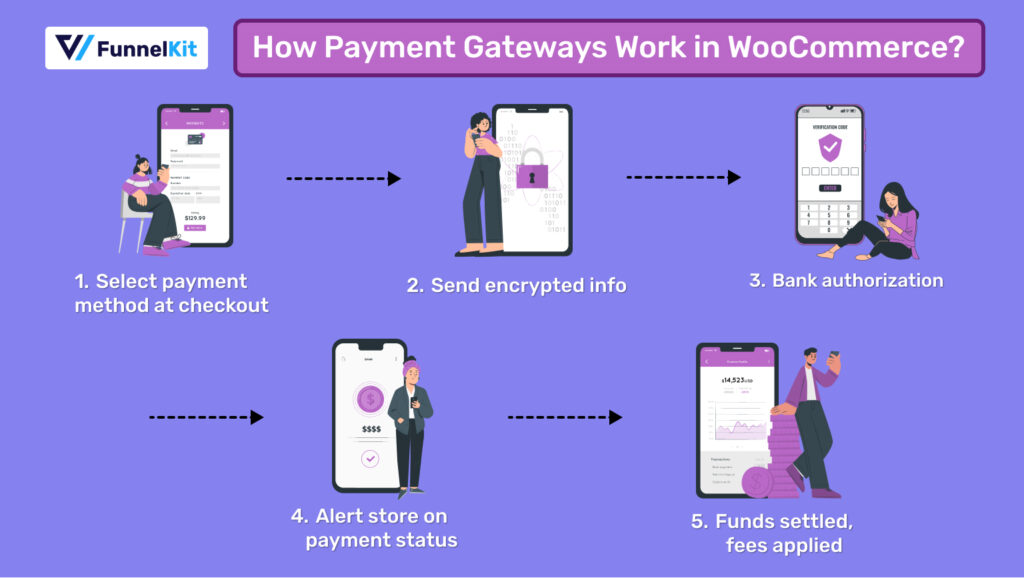
Step 1: Customer selects a payment method at checkout
Customers add items to their carts and navigate to the checkout page, where they choose a payment option such as Credit/Debit Cards, PayPal, or Buy Now, Pay Later (BNPL).
Once the payment method is selected, customers provide the necessary details:
- For Credit/Debit Cards, they enter the card number, expiration date, CVV, and cardholder name.
- For PayPal, they are redirected to PayPal’s site to log in and confirm the payment.
- For Google Pay and Apple Pay, customers may need to authenticate the transaction through their saved cards from their respective Google or Apple accounts.
- For BNPL, users need to provide their payment details and select the number of installments for completing the payment.
Step 2: Secure encryption and transmission of payment details
After customers submit their payment details, the information is encrypted and securely transmitted to the payment gateway.
Then, the payment gateway sends the transaction details to the customer’s bank for authorization.
Step 3: Bank verification and transaction authorization
Once the bank receives the payment details, the bank verifies the transaction by checking for the following:
- Sufficient Funds: Make sure the customer has enough balance or credit.
- Account Validity: Confirm that the account is active and has no fraud alerts.
After verification, the bank then sends the authorization result back to the payment gateway.
Step 4: Payment gateway notifies the store of authorization status
The payment gateway communicates the authorization status back to the WooCommerce store.
Depending on the status, the store shows users the message:
- Approved: The customer also receives a notification about the payment to the store.
- Declined: The customer is notified of the decline and can select a different payment method.
Step 5: Funds settlement and merchant fees
For successful transactions, the funds are processed and settled into the merchant's account, typically within a few business days.
The payment gateway charges the merchant processing fees. This fee varies depending on the payment gateway used in WooCommerce.
Step 6: Order placement confirmation
After the payment is successfully processed, the customer’s order is immediately placed in the WooCommerce store, and the customer is redirected to the thank you or order confirmation page.
Why Use Multiple Payment Gateways in WooCommerce?
You should use multiple payment gateways in WooCommerce because WooCommerce, by default, doen’t offer enough payment options.
By default, WooCommerce offers three payment methods:
- Direct bank transfer
- Check payments
- Cash on delivery
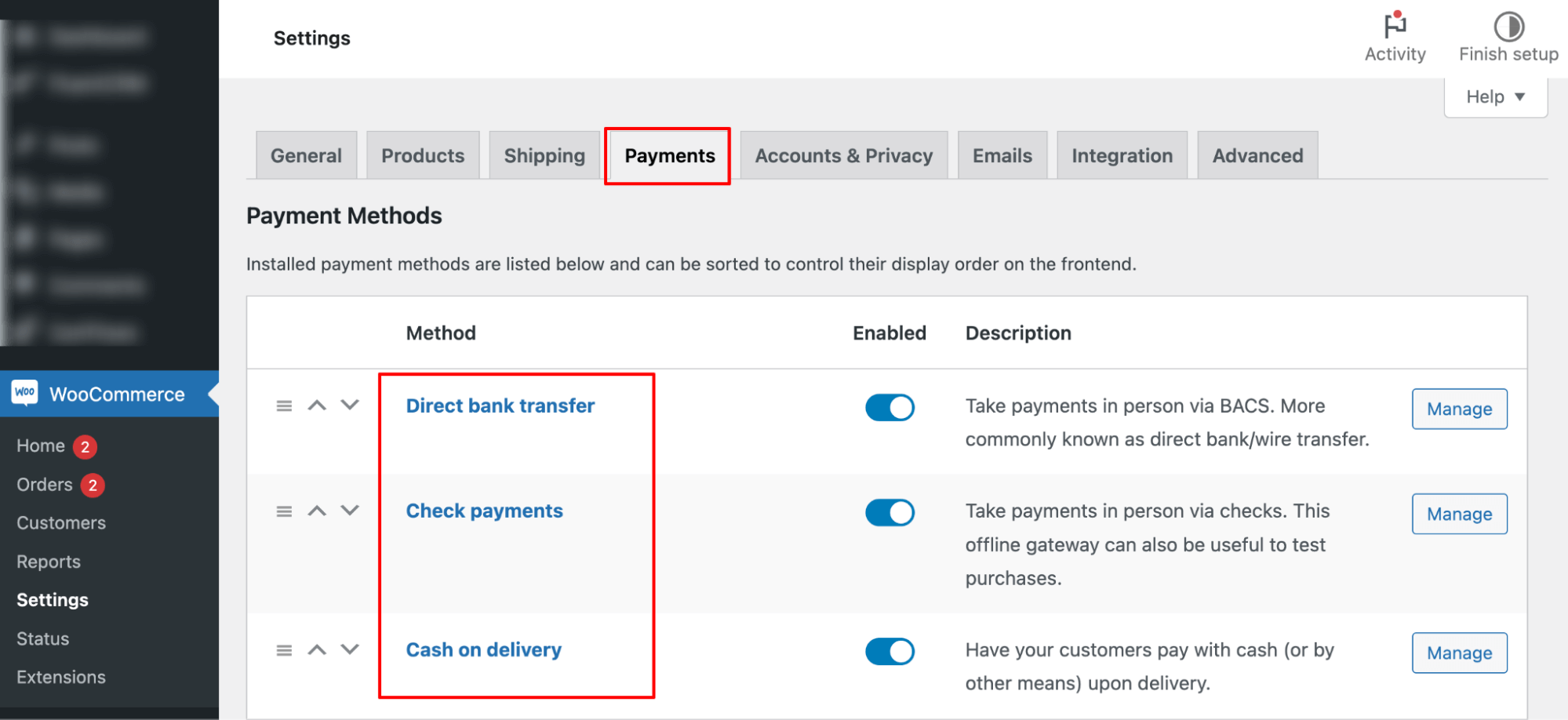
And, of course, with the ever-evolving digital shopping experience, offering just the default options is not enough.
You should offer a wide range of payment options, which is only possible by integrating multiple payment gateways into WooCommerce.
Here are some of the reasons why you should use multiple payment gateways in WooCommerce:
- Catering to diverse preferences
Every customer has their preferred payment method. Some may prefer credit cards, others express checkout options, and some may want cash on delivery. Offering various payment gateways helps you meet everyone’s needs.
- Global reach
Different regions have unique payment preferences. You can tap into international markets and cater to local customers by implementing multiple gateways.
- Enhanced checkout success
Payment failures can lead to cart abandonment. With multiple gateways, you reduce the risk of transaction issues, ensuring a smoother checkout process.
- Improved security
Popular payment gateways are highly secure. Integrating them into your WooCommerce store enhances the security of online payments.
- Flexibility and scalability
As your business grows and new payment trends emerge, multiple gateways offer flexibility, allowing you to add new methods quickly.
In conclusion, using multiple payment gateways not only enhances customer satisfaction but also positions your WooCommerce store for success in an ever-evolving marketplace.
5 Top Payment Gateways for WooCommerce
1. Stripe
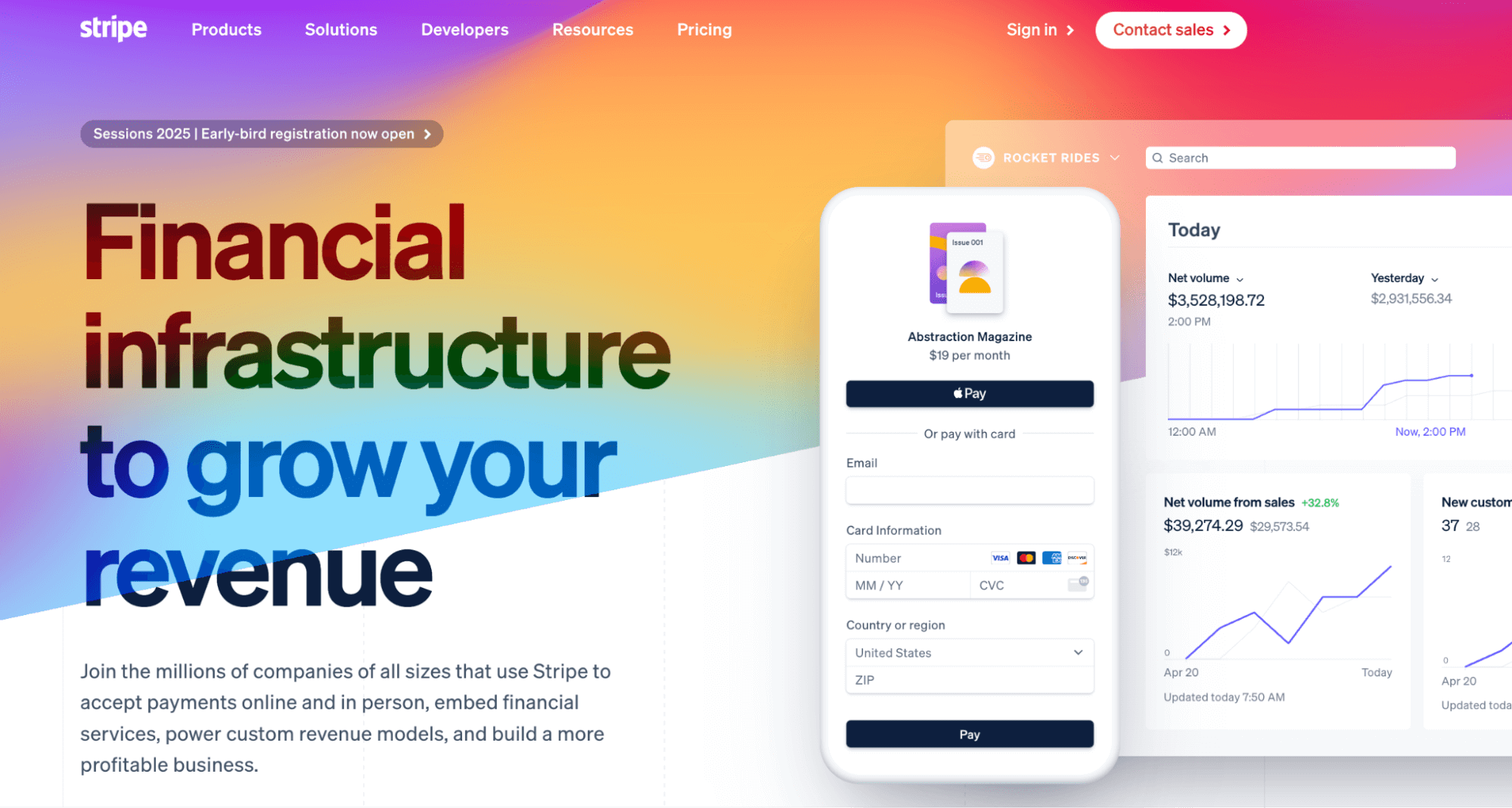
Stripe is a powerful and flexible payment gateway that you can easily integrate with WooCommerce.
It’s super safe, and its advanced fraud detection provides secure gateways for customers to do online transactions.
Key Features:
- Along with one-time payments, this gateway also accepts recurring payments
- Supports 132+ currencies around the world
- Credit and Debit Cards such as Visa, Mastercard, American Express, Discover, JCB, etc.
- Express checkouts such as Apple Pay and Google Pay.
- Local payment gateways include SEPA, iDEAL, P24, Bancontact, and many more.
- Buy now and pay later options like Affirm, Klarna, and Afterpay.
Transaction fees:
- No monthly fees or setup costs, but additional fees apply for each transaction and advanced features like Billing or Connect.
- Online payments: 2.9% plus $0.30 per successful charge.
- In-person payments: 2.7% plus $0.05 per successful charge.
- ACH credit: $1 per ACH credit payment.
2. Paypal

PayPal is one of the most recognized and trusted payment gateways in the world, offering a seamless experience for both merchants and customers.
It’s quite easy to integrate with WooCommerce to start accepting payments securely.
Key Features of PayPal Payment Gateway:
- Available in more than 200 countries/regions and supports 25 currencies.
- Accepts major credit and debit cards like Visa, Mastercard, American Express, Discover, and more.
- Offers express checkout options such as PayPal One Touch, Apple Pay, and Google Pay.
- Integrates with local payment methods, including SEPA, iDEAL, Bancontact, Sofort, and others.
- Buy now, pay later solutions are available through PayPal Credit and partnerships with services like Klarna.
- Enhanced security with advanced fraud protection tools.
- User-friendly interface and integration options for websites and e-commerce platforms.
Transaction fees:
- Standard transaction fee: 2.9% + $0.30 per transaction for domestic payments.
- For international transactions, a fee of 4.4% + a fixed fee based on currency received may apply.
- No monthly fees, but additional fees may apply for advanced features, such as PayPal Payments Pro.
3. Square
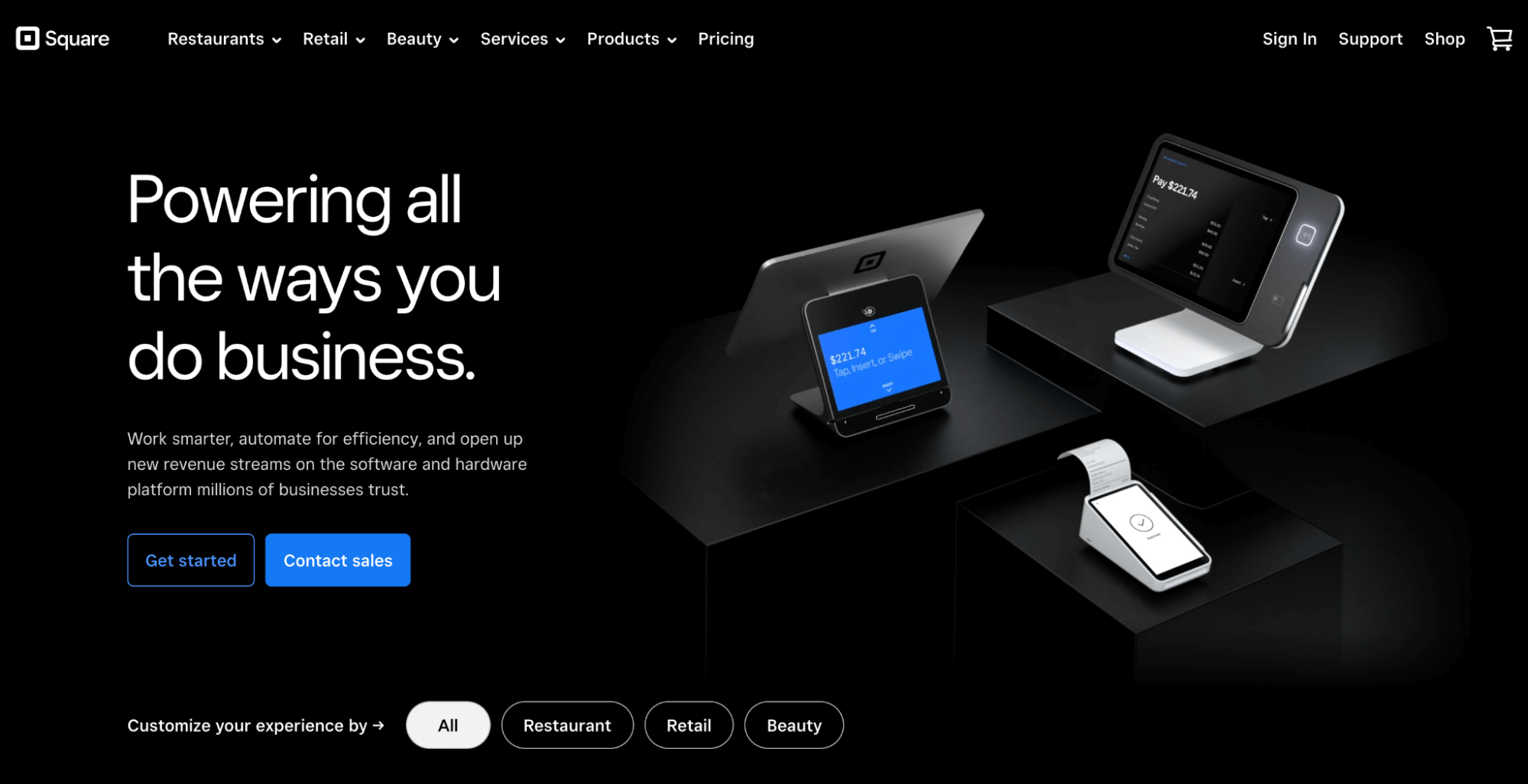
Square is an all-in-one payment solution designed for businesses of all sizes. Known for its user-friendly interface and robust features, Square allows merchants to accept payments seamlessly both online and in-person.
Its unique capabilities for multi-channel retail make it particularly attractive for businesses that operate both online and offline, providing a cohesive experience for customers.
Key Features of Square Payment Gateway:
- Supports one-time payments and recurring billing, allowing businesses to manage various payment types effortlessly.
- Accepts payments in 130+ currencies, making it a great choice for international sales.
- Accepts major credit and debit cards including Visa, Mastercard, American Express, and Discover.
- Provides contactless payment options, including Apple Pay and Google Pay, for quick and convenient transactions.
- Integrates with local payment methods such as ACH transfers, and also supports international cards.
- Offers a built-in point of sale (POS) system for in-person payments, along with online payment solutions.
- Provides a comprehensive dashboard for tracking sales, inventory, and customer insights.
- Equipped with advanced security features, including encryption and fraud detection tools.
Transaction fees:
- Standard transaction fee: 2.6% + $0.10 per transaction for in-person payments.
- For online payments, the fee is 2.9% + $0.30 per transaction.
- No monthly fees or hidden charges, but additional fees may apply for features like Square Payroll and Square Marketing.
4. Amazon Pay
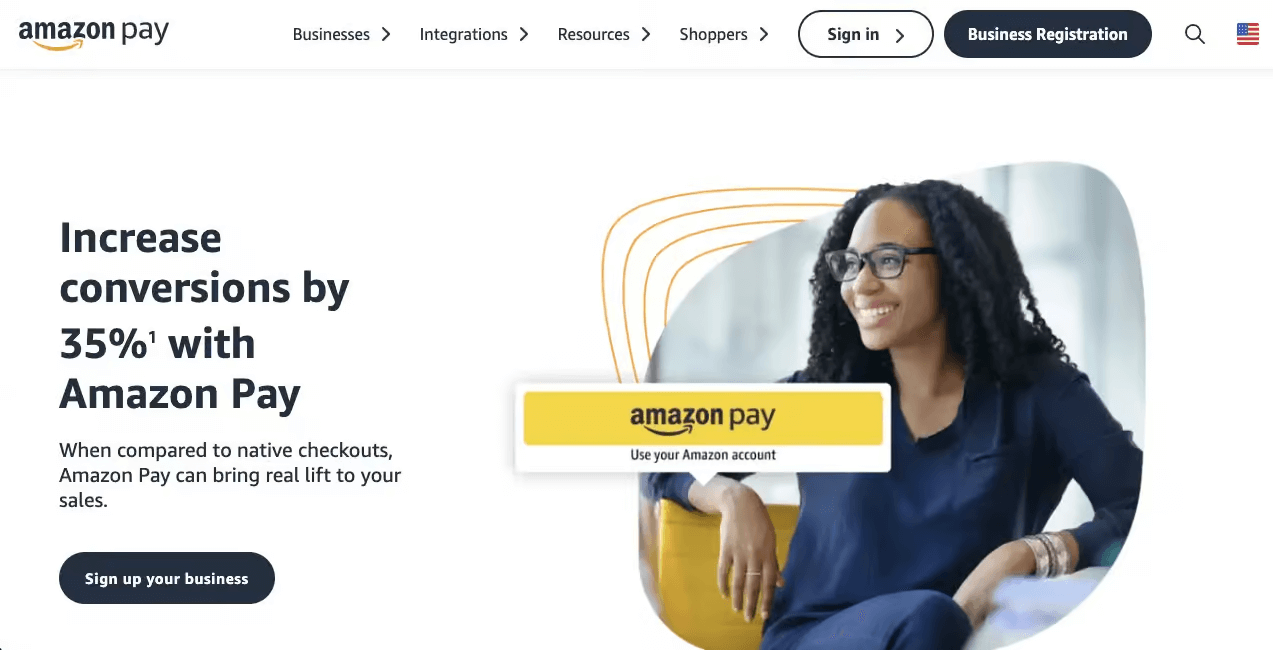
Amazon Pay allows customers to use their Amazon account information to make purchases on your WooCommerce store.
This familiarity can increase trust and conversion rates, especially for customers who are already comfortable shopping with Amazon.
Amazon Pay is highly secure and offers a streamlined checkout process. Apart from that, there are some other things to consider. Check out below:
Key Features of Amazon Pay:
- Allows customers to use their Amazon account to make purchases, simplifying the checkout process for users already familiar with Amazon.
- Supports multiple payment types, including credit and debit cards, and Amazon Pay balance.
- Accepts payments in various currencies, making it suitable for international sales.
- Provides a seamless integration with e-commerce platforms and custom websites, enhancing user experience.
- Offers one-click checkout for Amazon users, leading to reduced cart abandonment and increased conversion rates.
- Fraud protection tools are included, helping to secure transactions and customer data.
- Provides businesses with access to Amazon’s customer base, potentially reaching millions of existing Amazon customers.
- Includes features like recurring payments and subscription services for businesses with ongoing billing needs.
Transaction fees:
- Transaction fees: Typically 2.9% + $0.30 per transaction for domestic sales (this may vary based on the seller's volume and country).
- For international transactions, fees can be higher, typically 3.9% + a fixed fee based on currency.
- No monthly fees or setup costs, but additional fees may apply for specific services.
5. WooCommerce Payments
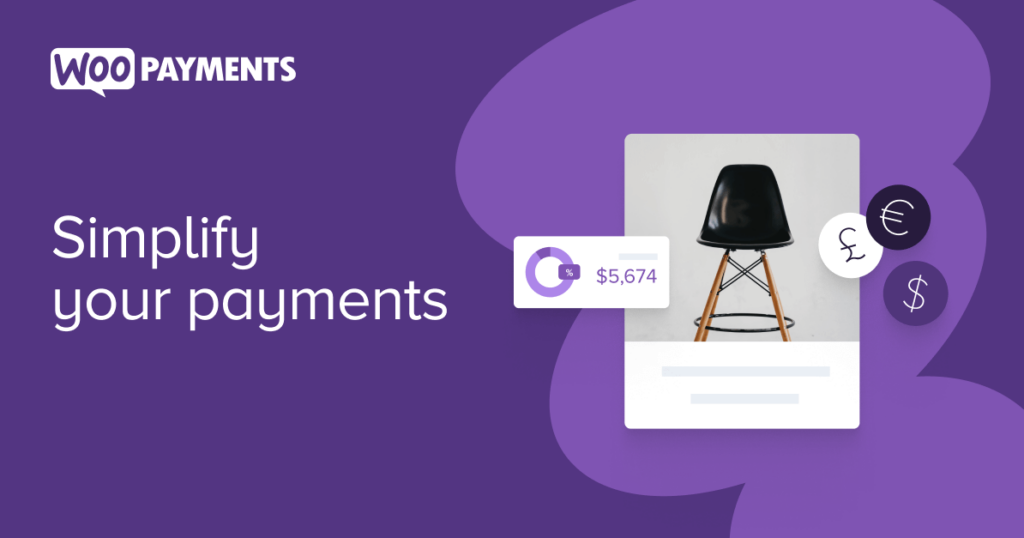
WooCommerce Payments is a payment solution built by WooCommerce, specifically designed for WooCommerce stores.
It offers seamless integration and allows you to manage all payments directly from your WooCommerce dashboard. WooCommerce Payments supports all major credit and debit cards and provides detailed insights into your transactions.
Key Features of WooCommerce Payments:
- Accepts major credit and debit cards, including Visa, Mastercard, American Express, and Discover.
- Built-in payment management enables the handling of payments, refunds, and chargebacks directly from your WordPress dashboard.
- Supports multiple currencies, allowing businesses to accept payments internationally.
- Recurring payment functionality for businesses offering subscriptions or memberships.
- Equipped with advanced security features to protect transactions and customer data.
- Offers automated payouts to your bank account on a daily basis, ensuring quick access to your earnings.
- Provides real-time reporting tools to track sales, payment status, and customer insights.
Transaction fees:
- Transaction fees: Typically 2.9% + $0.30 per transaction for domestic payments.
- For international transactions, fees may be higher, typically 3.9% + a fixed fee based on currency.
- No monthly fees or setup costs, but additional fees may apply for specific features.
👉 For more details, read our blog on Best WooCommerce Payment Gateways for Fast and Secure Transactions.
✅ Experts recommendation
The payment gateway you choose depends on your customer base. Our experts highly recommend Stripe.
When you want to offer local payment methods or take payments internationally, Stripe is the right choice because it supports all types of debit cards, credit cards, and local payments.
Plus it also supports recurring payments and integrates with Buy Now Pay later platforms like Affirm, Klarna, and Afterpay.
Moreover, Stripes will help you to achieve your ultimate goal which is to boost sales and average order value.
One of the effective ways to boost order value is one-click upsells that is offered to users right after checkout. Users are not required to share their payment details a second time. Rather, they can just accept and add the upsell offer to their main offer with a single click.
Stripe supports multiple payment methods, including buy now, pay later methods for one-click upsells.
So, Stripe should be your number-one choice if you want to cater to a large audience who may want to buy from your store using different payment methods.
Let’s move to the next section to find out how to add Stripe payment gateways to WooCommerce.
How to Add a Stripe Payment Gateway in WooCommerce?
To add Stripe to WooCommerce, we will use the FunnelKit Stripe gateway plugin.
This plugin streamlines the onboarding process for users. After connecting to Stripe, it automatically retrieves live and test keys, eliminating the need for manual input. Additionally, it simplifies webhook integration by instantly syncing webhooks from your Stripe account, removing the hassle of manual copy-pasting.
With this plugin, you can add all the goodesses of Stripe to WooCommerce and integrate all the payment methods seamlessly for both checkout and upsell offers.
Make sure to install and activate this plugin.
Next, follow these steps:
You can also refer to the video if you are not in the mood to read 👇

Step 1: Connect and configure your Stripe account with WooCommerce
After activating the plugin, click on the Configure Stripe button to start the onboarding process.

Next, provide the email address you used to open your Stripe account. Then, click on Continue. Next, provide the password and click login.

After that, you need to provide a verification code. You will receive it on your registered phone number.
Now, choose the account and click on Connect.
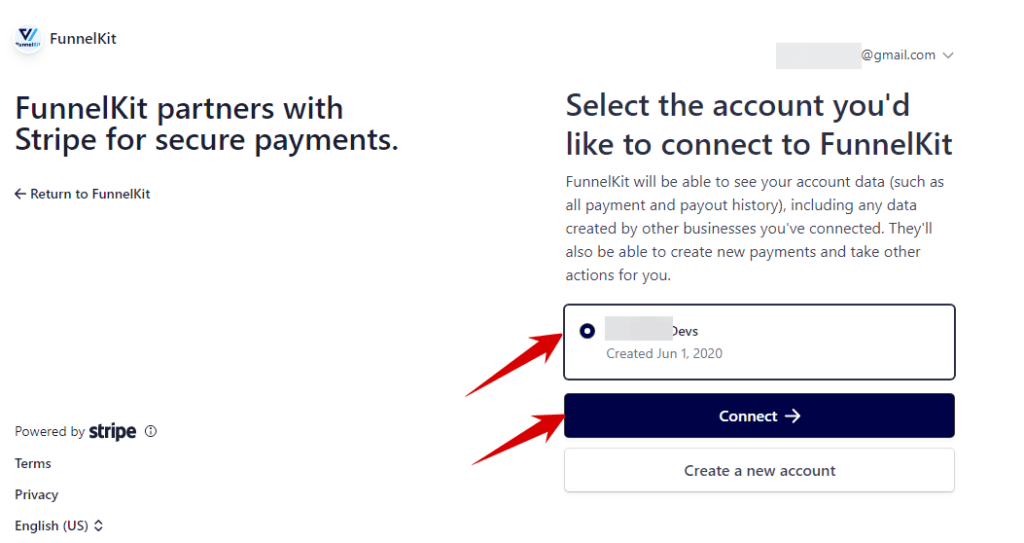
Now, turn on the toggle button to enable all the credit card (Stripe) options. This option will allow your customers to pay with major credit and debit cards.
Then click on Save and Continue.
Now, turn on the toggle button to enable all the credit card (Stripe) options. This option will allow your customers to pay with major credit and debit cards.
Then click on Save and Continue.
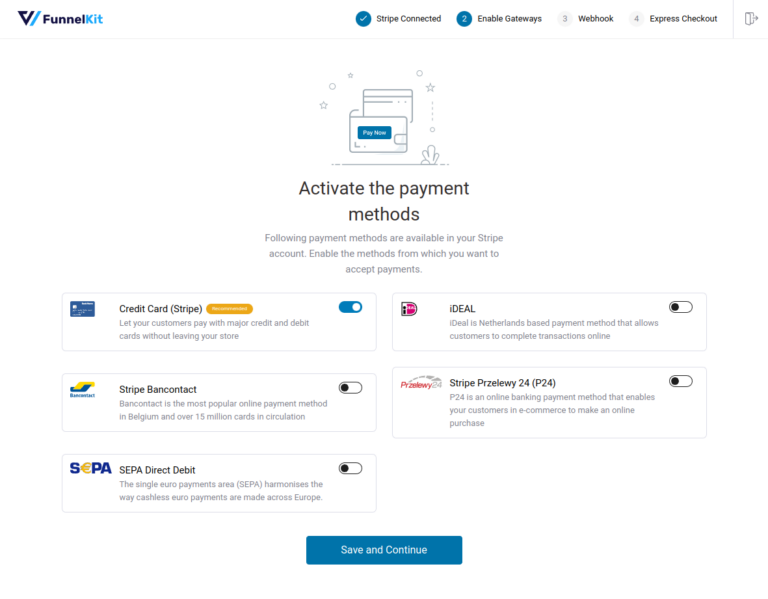
Next, you need to create a webhook. To do that, click on Setup Webhook Now. Stripe Gateway for WooCommerce By FunnelKit will take care of everything for you.
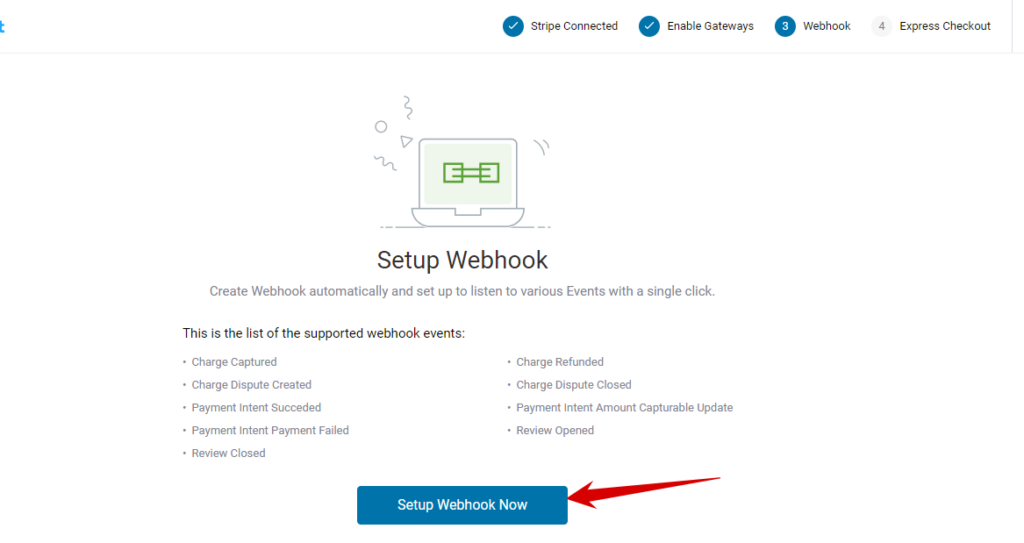
To enable the Express Checkout, turn the toggle button on and then hit Confirm.
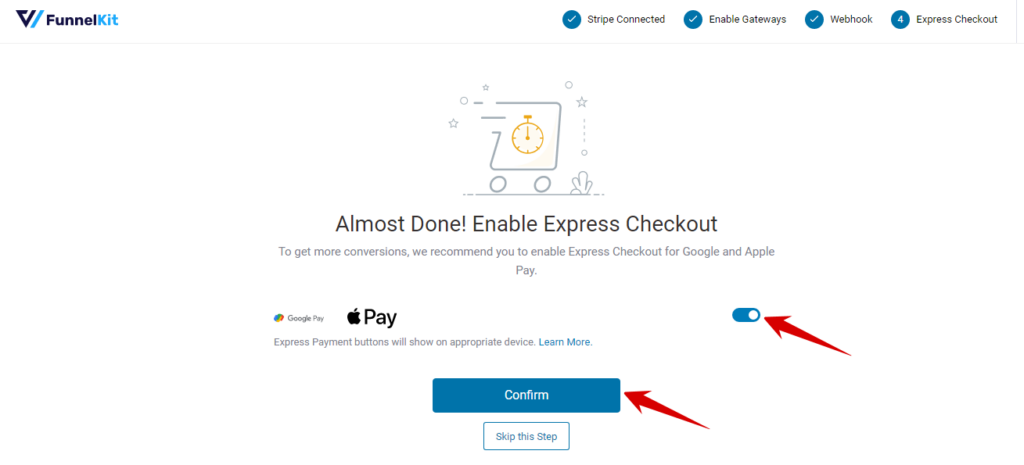
Lastly, you need to click on choose the mode weather test or live and then save the settings.
Note: It's recommended to check the whole process with test mode first.
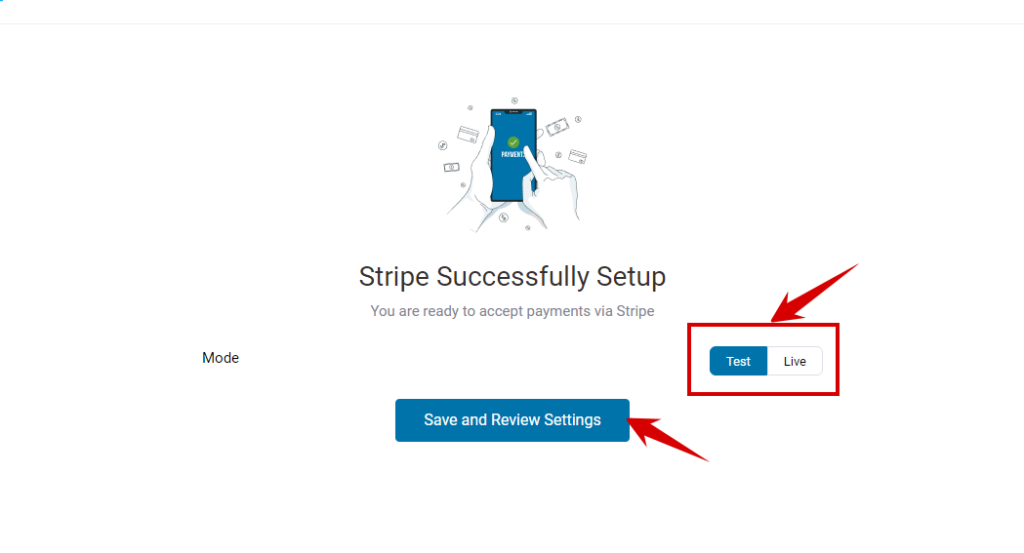
Clicking on 'Save and Review Settings' will integrate Stripe with your WooCommerce store.
After that, you will be redirected to the WordPress dashboard.
Step 2: Enable credit card payments
Under the Credit Cards Section, you can customize the following settings:
- Enable Stripe Gateway: Enable to use Stripe's online credit card payment service.
- Title: Provide the title that will show up on the checkout page.
- Description: Here, you can provide the description.
- Statement Descriptor: Provide a separator that will show up on the customer's statement.
- Charge Type: Here, you can choose the charge type. There are two options: Charge and Authorize. The Charge method is used to authorize and capture a credit card payment. On the other hand, Authorize is used to authorize the payment.
- Saved Cards: Enabling this option will save card details for future transactions.
- Inline Credit Card Form: You can turn this option to enable inline credit card payment.
- Allowed card: Here, add the cards you want to allow for payment in your store.
Once you make all the changes, click on Save Changes to update.
Note: To learn what each setting is about, hover on the “?” icon.
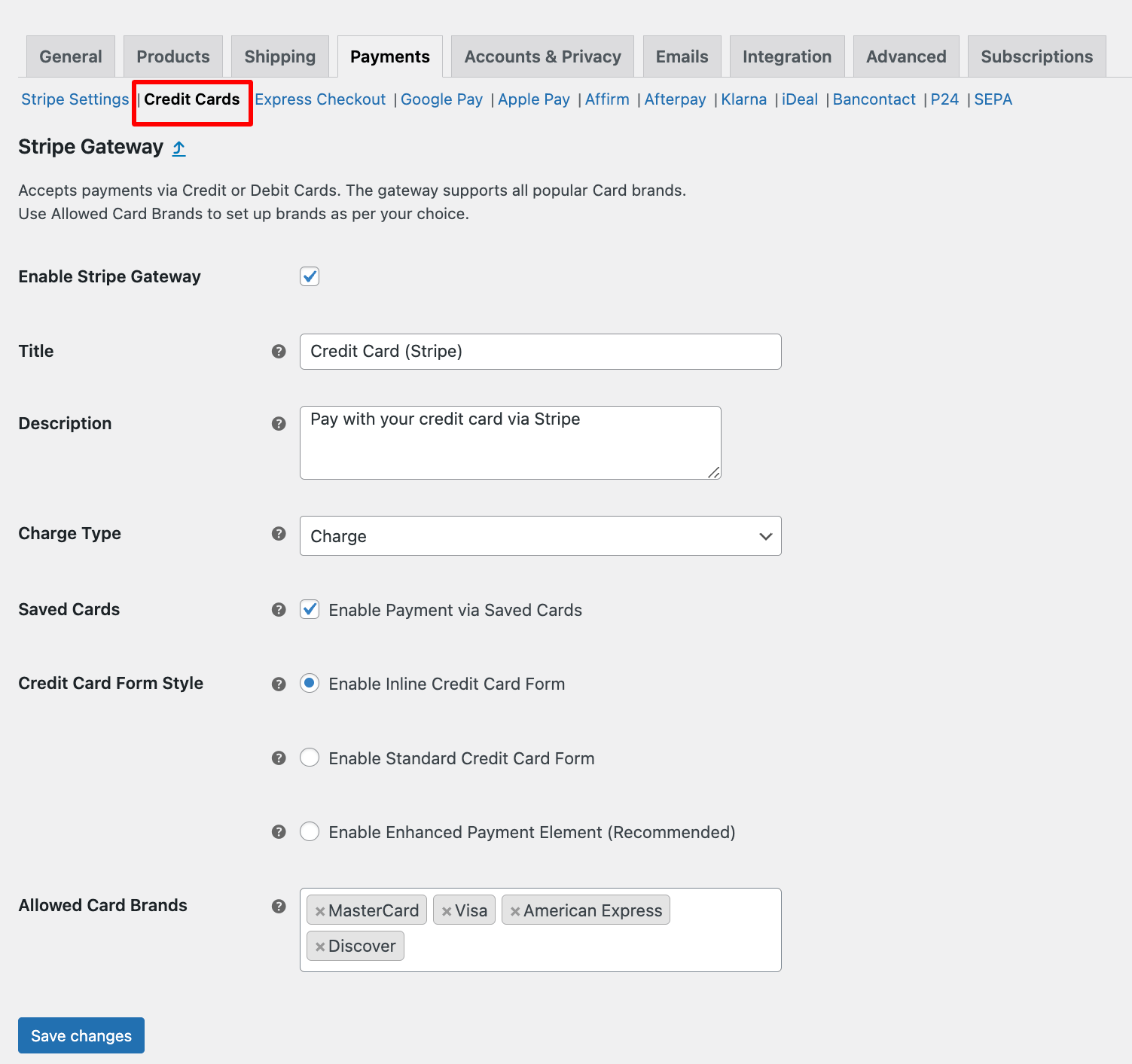
Step 3: Enable express checkout Google Pay and Apple Pay
Next, move to the express checkout option to enable one-click express payment option like Google Pay and Apple Pay.
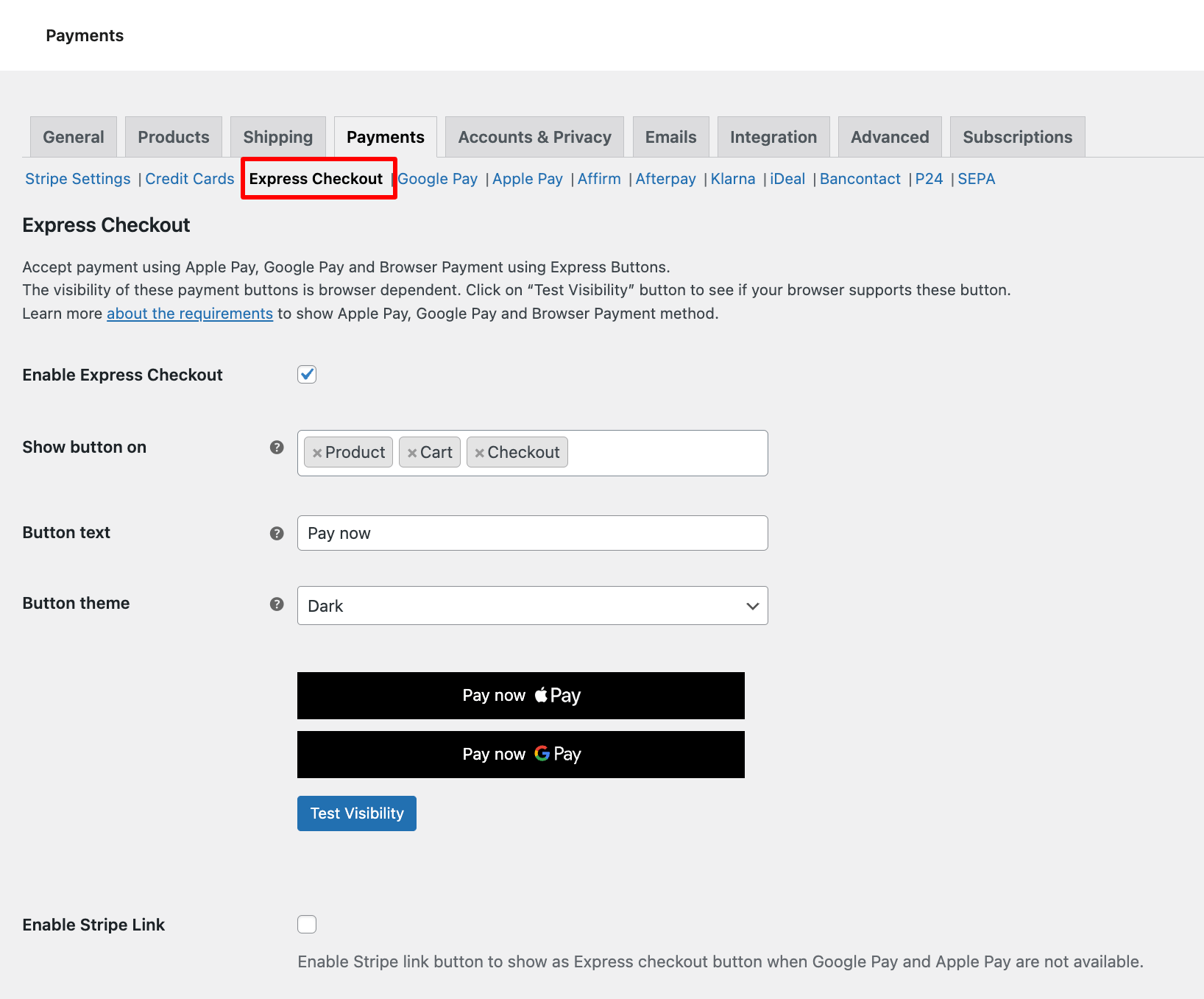
You can also add Google and Apple pay options as inline like the rest of the payment options in case you need customers to fill out any required information before they come to the payment section.
You can enable the Inline payment option under Google Pay and Apple Pay tab.
For more details, check our blog on Google Pay and Apple pay.
Step 4: Enable local payments
In case you want to allow local payments in your store, you can do that on the related tab.
Let's say you want to configure the iDeal payment option on your site. You need to go to the iDeal tab, enable th option, and configure the necessary settings; for more details, read our blog on WooCommerce iDEAL Payments .

Just like iDeal, customize other payment options like Bancontact, P24, and SEPA.
Step 5: Enable Buy Now Pay Later options

With Stripe, you can also offer buy now, pay later payment options. To do this, go to the WooCommerce Settings ⇒ Payments section.
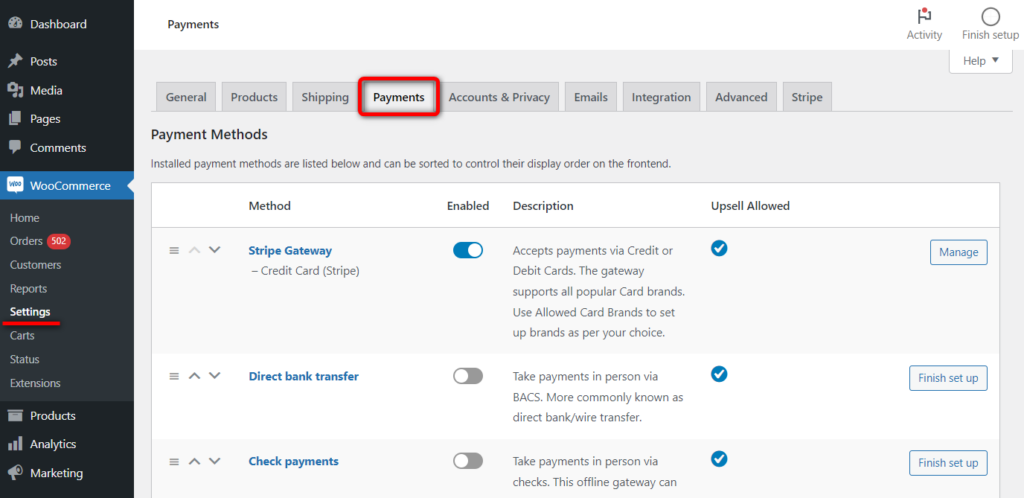
Here, you will find all the BNPL options like Affirm, Klarna, and AfterPay.
Hit the ‘Manage’ button next to it you want to use. Here, we are showing Klarna as an example.
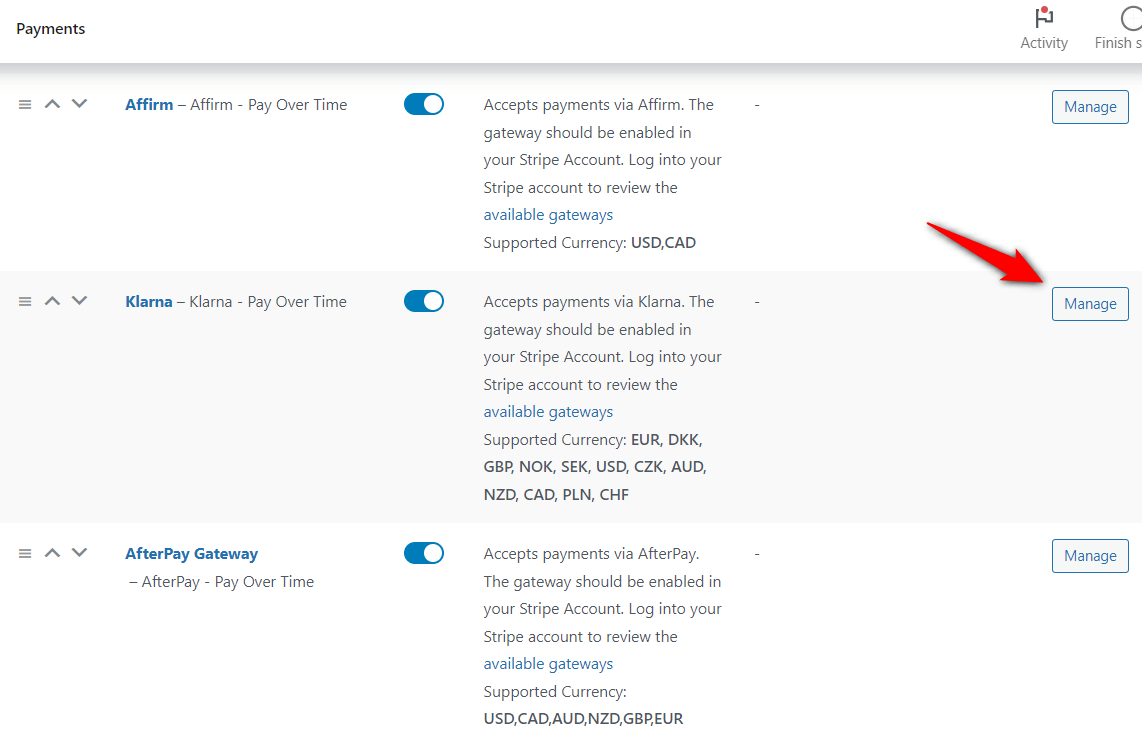
Next, check the option next to ‘Enable Klarna Payments’.
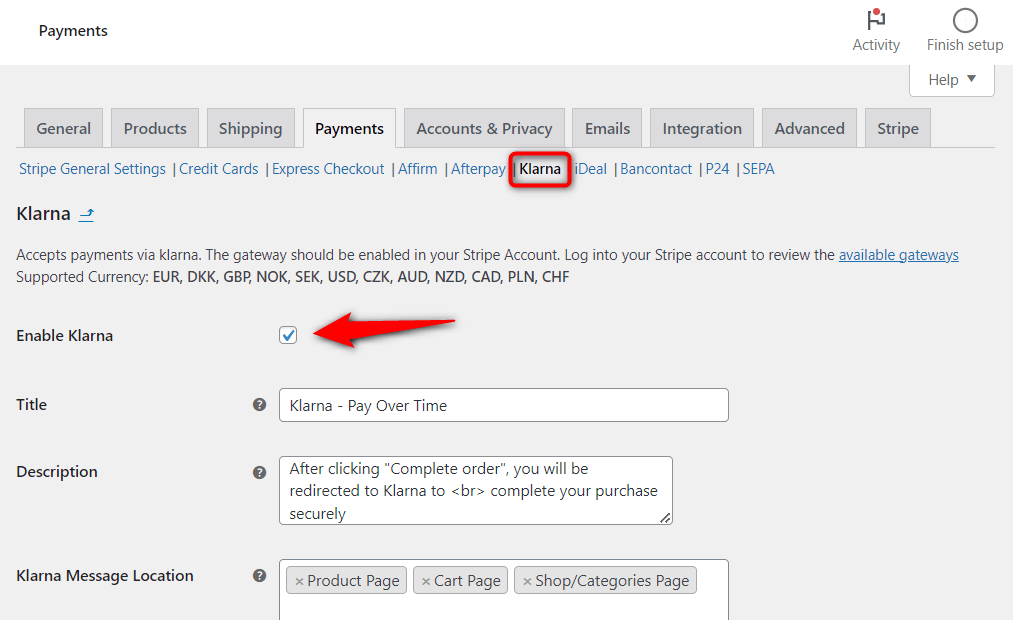
Next, configure the necessary settings and save them to update the status.
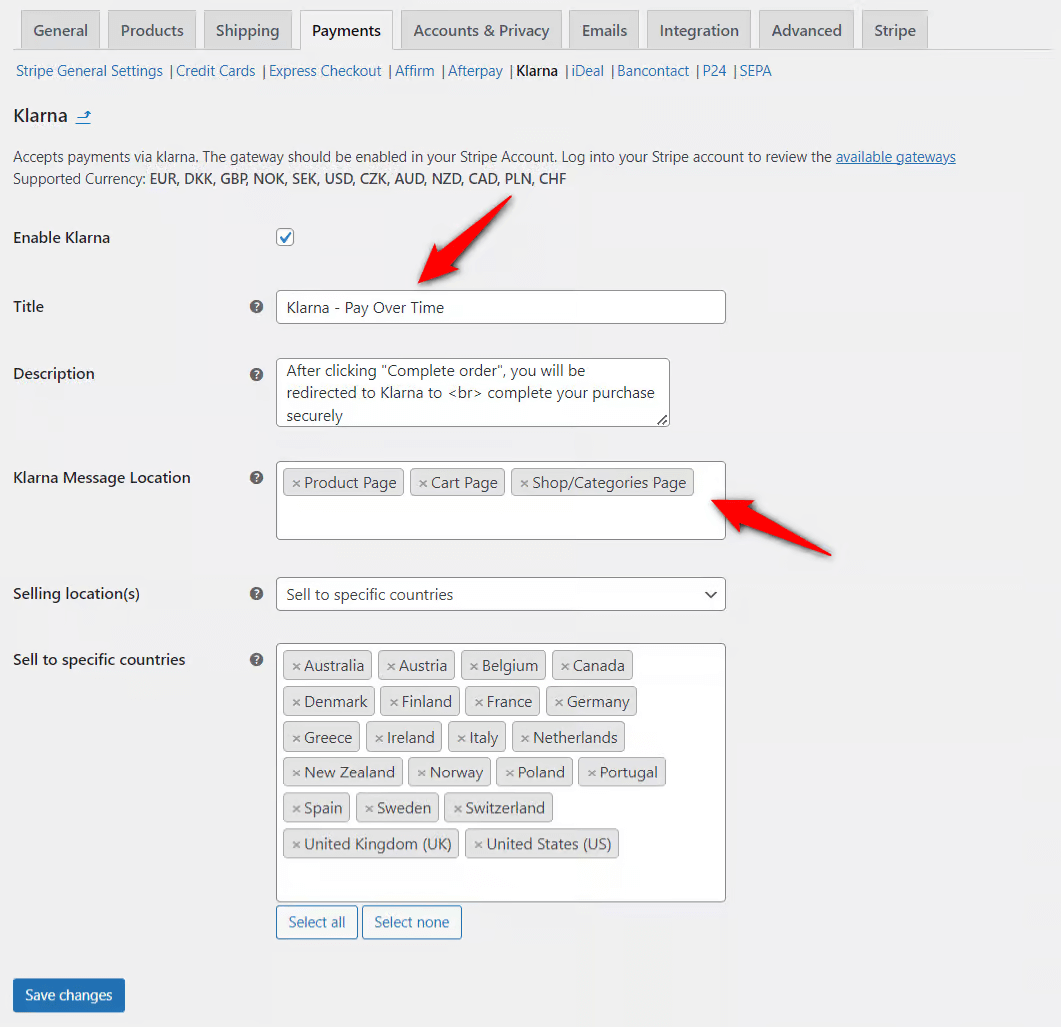
For more details, read our blog on “WooCommerce Klarna Payments.”
You can also check our guide on WooCommerce Affirm payments and Afterpay payments.
This is how you can set up many payment options using Stripe in WooCommerce.
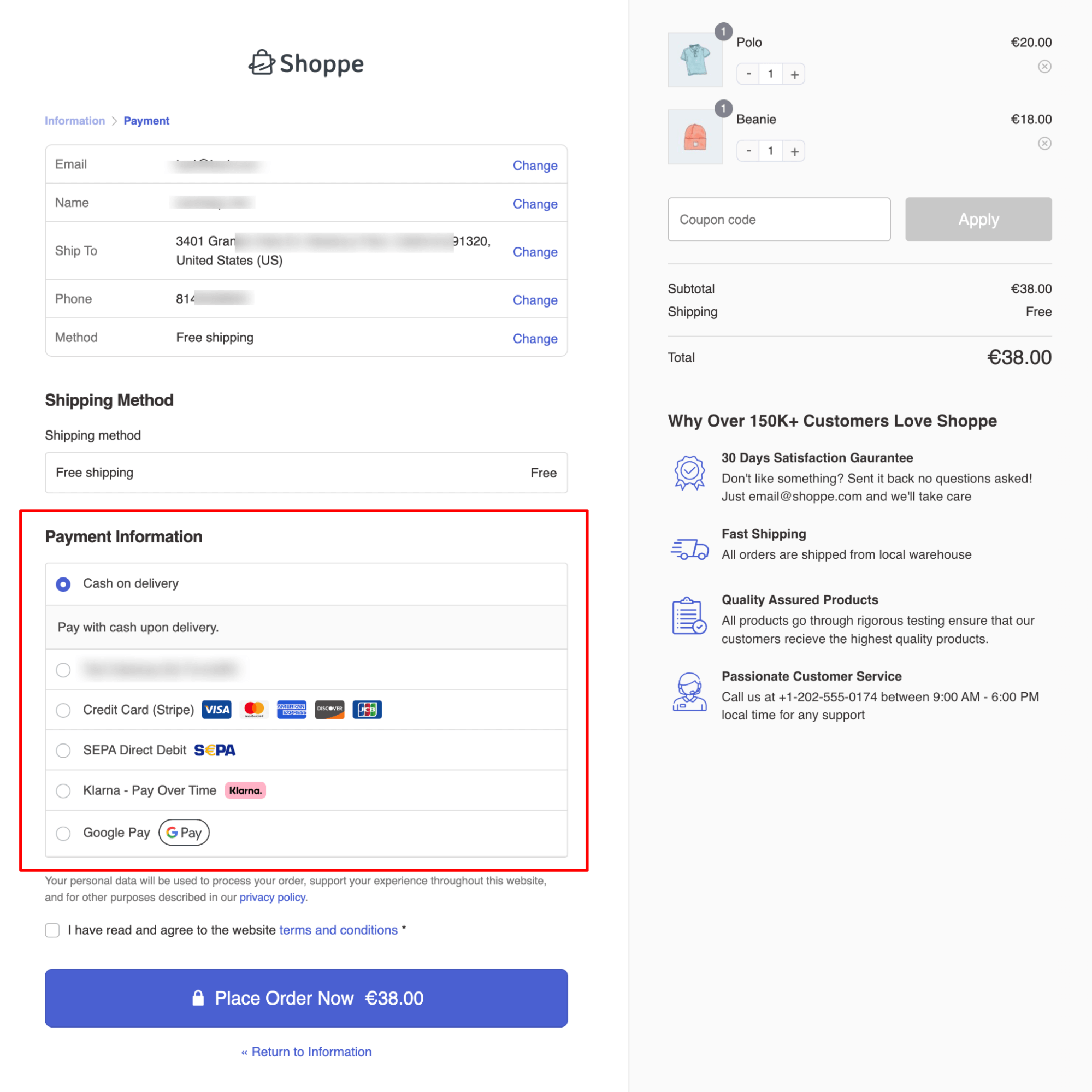
🔔 The beautiful 2-step checkout page you can see above is built with FunnelKit Funnel Builder.
How to Add Paypal Payment Gateway to WooCommerce Store?
To add Paypal payment gateway t to your WooCommerce store, follow these steps:
Step 1: Connect the WooCommerce store to PayPal
You need to install and activate the PayPal AngelEye payment gateway plugin and connect to your PayPal account.
Step 2: Enable PayPal commerce
Next, navigate to WooCommerce ⇒ Settings ⇒ Payments and hit “Manage” for the option "PayPal Commerce - Built By Angelleye".
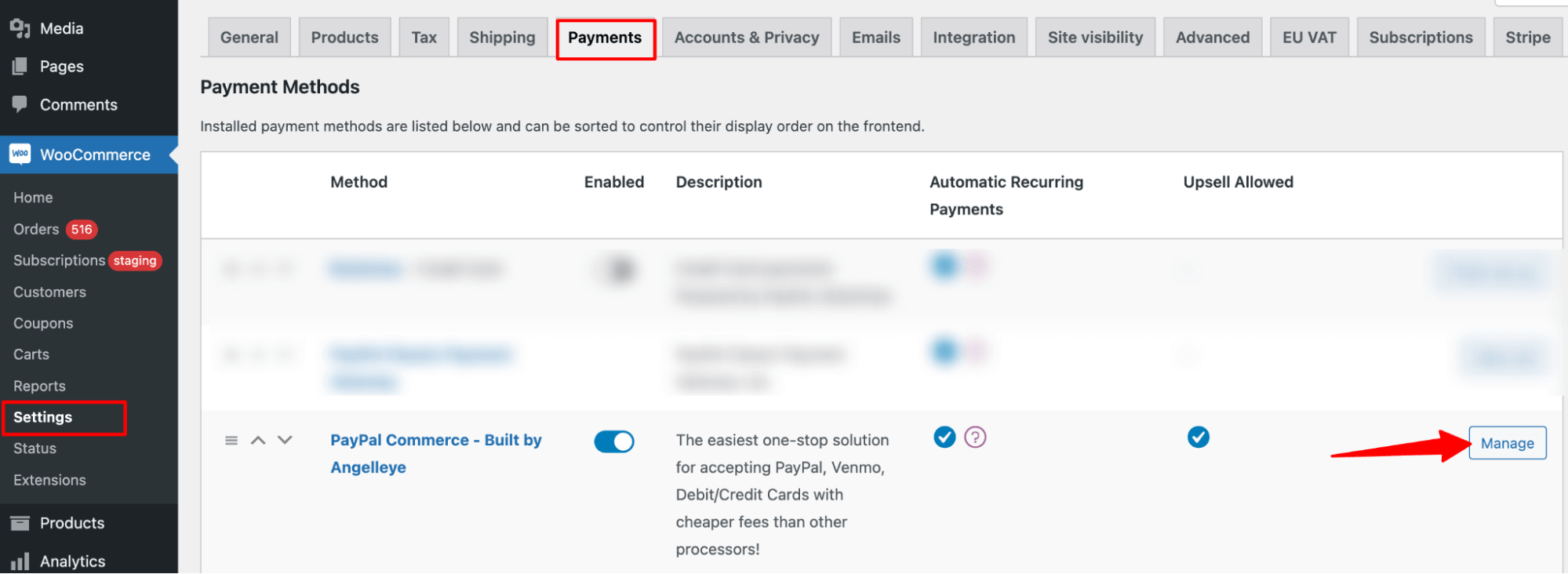
Enable the option “PayPal Commerce” and set up the title and description.
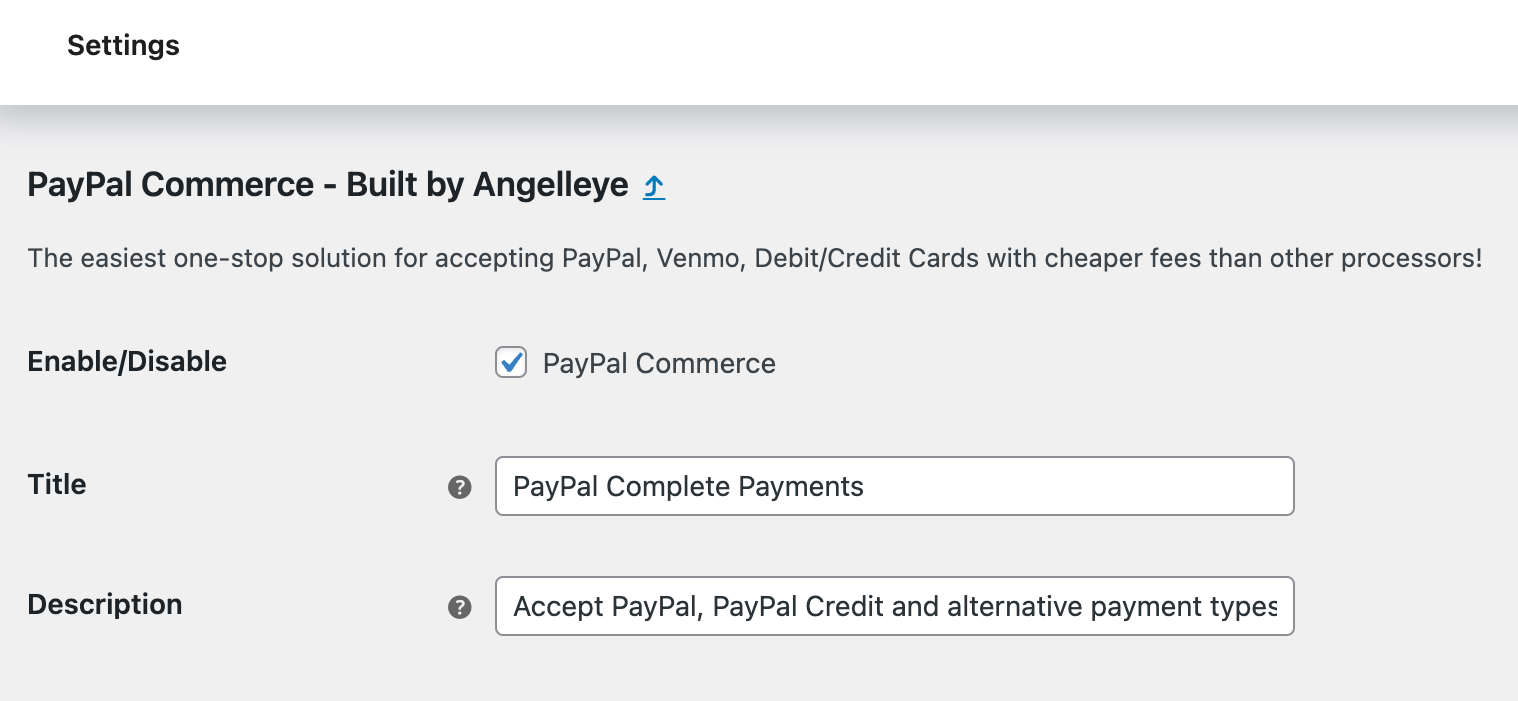
Step 3: Configure Paypal for the checkout page
You can configure different settings on Paypal to show up WooCommerce pages, including the Product page, cart page, and checkout page.
For instance, you can exclusively enable it or disable it for the checkout page.
Then, choose the display position and enable or disable the smart buttons. You can also change the button layout, color shape, and size.
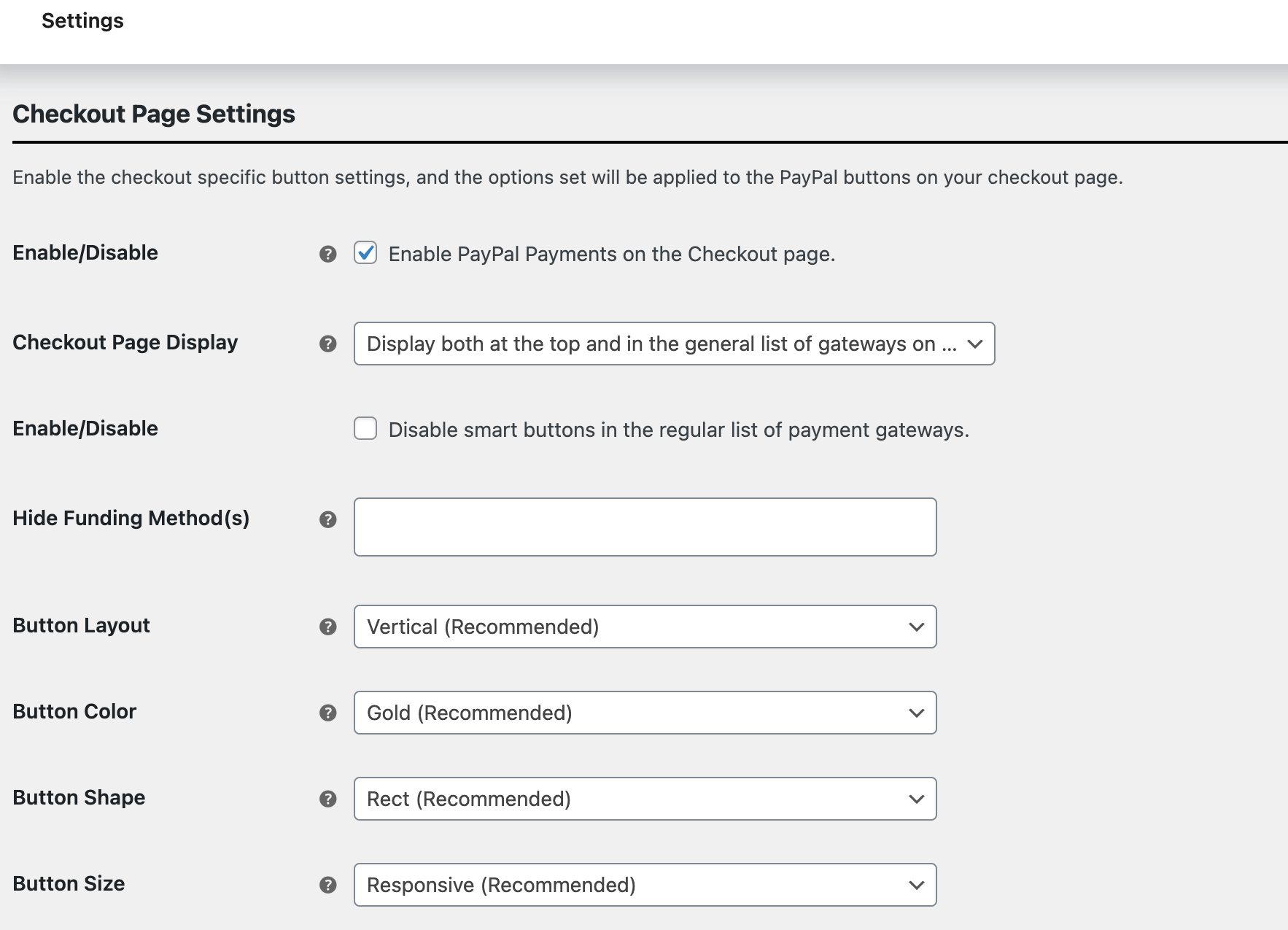
For example, on the checkout page, configure settings for the product page and cart page.
Once done, make sure to save the changes.
Here is what PayPal payments look like on the checkout page. As you can see, both Stripe and PayPal are showing up beautifully.
🔔 Note: FunnelKit Funnel Builder is totally compatible with Stripe and Paypal plugins. As you can see, payments through multiple gateways are displayed in a clean, streamlined, and user-friendly way on FunnelKit’s checkout page.

Frequently Asked Questions About Multiple Payment Gateway For WooCommercee
- Will using multiple payment gateways affect my website's performance?
Generally, using multiple payment gateways should not significantly affect your website's performance. However, it’s essential to choose reputable payment gateway plugins and ensure they are updated regularly to minimize any potential impact.
- Can I customize the checkout process when using multiple payment gateways?
Yes, WooCommerce allows for customization of the checkout process when using multiple payment gateways. To customize your WooCommrce checkout page to make it more conversion-optimized, use FunnelKit Funnel Builder.
- Are there any additional fees associated with using multiple payment gateways?
While WooCommerce itself does not charge fees for using multiple payment gateways, each payment provider may have its own fee structure, including transaction fees, monthly fees, or setup costs. We have shared the fees of popular payment gateways like Stripe, Payal, Square, etc in this blog.
- How do I troubleshoot issues with payment gateways in WooCommerce?
To troubleshoot issues with payment gateways, start by checking the gateway settings and ensuring that API keys are correctly configured. Look for error logs in WooCommerce to identify specific issues, and consult the documentation or support resources for the payment gateways you are using.
Ready to Offer Multiple Payment Gateways in WooCommerce?
Offering multiple payment gateways is crucial for catering to customers with different payment preferences.
While Stripe covers many needs, if your audience prefers options like PayPal or Amazon Pay, adding multiple payment gateways is a smart move to maximize reach.
However, always make sure the plugins you are using for the integration are compatible with each other, WooCommerce, and other existing plugins and themes you are using.
Along with offering multiple payment methods, if you want to further enhance the shopping experience in your store, then you should get your hands on FunnelKit Funnel Builder.
With this checkout page customizer plugin, you can optimize your checkout page with features like Google address autocomplete, auto-apply coupons, etc., which will surely boost your conversion rate.
Plus, if you want, you can replace the default checkout page with a multistep checkout as well or replace it with a stylish customer-friendly one-page checkout.
So, don’t just limit yourself to utilizing multiple payment gateways; start optimizing your checkout page as well for reduced cart abandonment and better conversion rates.
Get FunnelKit Funnel Builder today!
The post How to Offer Multiple Payment Gateways in WooCommerce appeared first on FunnelKit.